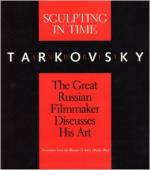|
This section contains 593 words (approx. 2 pages at 400 words per page) |

|
Chapter III Summary and Analysis
Tarkovsky distinguishes between linear time, history, and a more spiritual sense of time; the latter is that in which Tarkovsky is chiefly interested. In the spiritual, personal sense, time is related intimately to memory. Without memory, man is doomed to madness. Memory is also what makes mankind vulnerable, and subject to pain. Time allows man to be a moral being, to engage in a search for true. Time, in the form of memory, is always with us. To make sense of ourselves, we constantly look to the past and our own memory.
Switching gears, Tarkovsky states that film directing begins at the moment the director has, in his mind's eye, an image of the film. By committing to film his most secret and personal thoughts and dreams, the director becomes an artist.
The film that started cinema was the...
(read more from the Chapter III Summary)
|
This section contains 593 words (approx. 2 pages at 400 words per page) |

|




